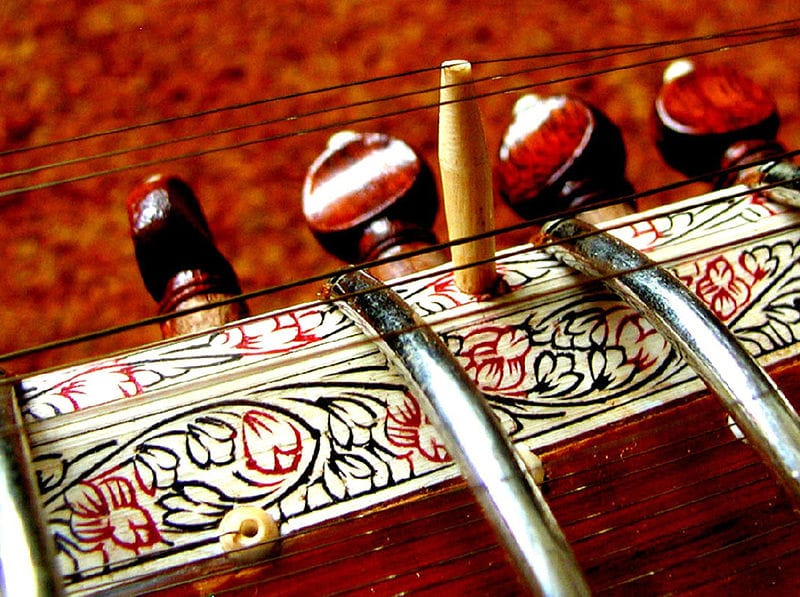CAN WESTERN MUSICAL STUDIES INTEGRATE INDIAN CLASSICAL MUSIC? SOME DIFFICULTIES, GREAT ADVANTAGES

It is quite clear that – at least at certain levels – we live in a globalised world. New technologies developed over the last years in the fields of transportation and digital communication are allowing us now to travel and access knowledge with remarkable ease and speed. Among other advantages, the access to different and distant cultures is now much more immediate and comfortable than ever. As a natural consequence, some of these “cultural discoveries” have become integrated in the society that imports them, with more or less intensity depending on the level of interest they generate.
The two elements that the West has imported most successfully from the vast traditional culture of India are, beyond doubt, yoga (we will not discuss here the degree of resemblance with the original / traditional forms of all what we call “yoga” in the Western world) and gastronomy. Other cultural areas and disciplines, such as the performing arts, have still a much weaker and discontinuous presence in most Western countries. They are also precious elements of the Indian tradition still not sufficiently present in those countries.
In the middle years of the last century, two major historical facts launched the expansion of Indian classical music in the West. The first and most important was the international tours accomplished by the legendary sitar player Ravi Shankar. An international impact significantly enhanced by his personal friendship with George Harrison, a member of the world-famous pop group The Beatles. The second factor was the exposure provided by a series of international concerts and commercial recordings promoted enthusiastically by the French scholar and musician Alain Daniélou.
However, as mentioned earlier, Indian classical music is still an artistic discipline with a rather weak and discontinuous presence in most Western countries. Concerts and workshops are occasionally organised and performed by Indian musicians as well as local musicians (with different levels of proper training). Unfortunately, a good number of the people attending those events are moved just by curiosity, without any other interest beyond the exotic factor. It is rare to see classical Indian music included in official and professional musical studies in Western countries. This is, we believe, an important factor. Integrating this music in the higher musical education may favour importantly to establish itself and also to gain prestige as well as continuity in the host culture. This is not the current scenario and several factors may be responsible for it.
Broadly speaking, a first impediment to overcome when trying to integrate a musical culture so distant and alien to the indigenous one – meaning not only one kind of music, but all which constitute the musical culture in use is a certain emotional rejection of what is alien to my own cultural identity, often felt like “too exotic for me”. This emotional reaction tends to “dignify” or “objectify” itself by comparing this new musical culture to the ones already accepted and integrated into one’s own culture. The usual objective of these comparisons is to discredit the foreign music, highlighting its “weaknesses” and establishing the supremacy of one’s own musical tradition.
Another obstacle that Indian classical music would have to overcome in order to expand its presence in schools and concert halls in Western countries is its unfortunate reputation as an “amusement for hippies”. The personal and professional connection between Ravi Shankar and The Beatles – and the psychedelic musical trends of that time – actually contributed significantly to this linkage between this two different realities (read what Ravi Shankar himself wrote in his book “My music, my life” and titled “Hippies and problems”). In connection with this, the superficial mystical / spiritual attitude of many aficionados approaching this kind of music does not help to be understood and practiced with the required artistic seriousness and depth.
Another significant obstacle we can mention is the difficulty of finding competent teachers in Western countries who can teach this kind of music on a professional level. The numbers of non-Indian musicians with a sufficiently solid training who can offer regular classes of this kind of music is still scarce. Professional musicians from India occasionally visit Western countries to perform and to offer classes / workshops. However, various circumstances prevent this kind of initiatives to consolidate into a sustainable educational phenomenon.
Instrumental music, exempt of lyrics in languages completely alien to most people, seems to enjoy greater acceptance than vocal music in the West. The classical musical system of India – based on the concept of raga – shows great adaptability to any melodic instrument with a sufficiently wide register. The issue lies with the characteristic way of ornamenting the melodic lines (gamaka, minda, andolana), which constitutes a fundamental element of the emotional eloquence of Indian classical music. In the West, some of the most popular instruments are unable to reproduce this kind of melodic ornamentation in a satisfactory manner. Instrumentalists are quite limited sometimes when trying to properly develop the raga.
One last difficulty we could point out here is the scarce literature in languages other than English. In order to spread the knowledge of this artistic tradition in a more massive way –being able to appreciate it more easily and deeply – it would be convenient to stimulate the publication of books in local languages. Doing so would help significantly to extend its knowledge beyond the academic and specialised circles.
The advantages of integrating Indian classical music in the musical studies of any alien culture may be quite obvious to any person familiar with it. Its artistic virtues are many: it helps to stimulate musical creativity for improvisation, offers a huge diversity of melodic scales, shows a wide range of different and exquisite ways of ornamenting the melodic lines, shows also a great number of unique metrical patterns for the rhythmic sections, possess a great instrumental richness (many of them with a characteristic and suggestive timber), the depth / transcendence of its artistic message. Integrating Indian classical music in the professional / official musical studies means enriching significantly the spectrum of musical experiences that a culture can offer. We believe it is worth considering the factors that would help to smooth and stimulate the process.





